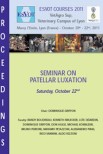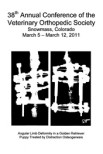A 7-month-old entire male English springer spaniel presented with a two-month history of bilateral forelimb lameness, worse on the left side. Clinical examination revealed bilateral elbow discomfort. A computed tomography (CT) scan was performed (Siemens Somatom Go-Top, Siemens Healthineers, Erlangen, Germany), which revealed bilateral humeral intraondylar fissures, more severe on the left side.
Using fluoroscopic guidance, a minimally invasive approach was employed to place a 4.5 mm transcondylar locking screw (Arthrex GmbH, Munich, Germany) bilaterally.
The patient was discharged with a five-day course of meloxicam and instructions for crate rest and short leash walks (10 minutes, three times daily) for 6 weeks. At 6 weeks postoperatively, the dog was reassessed; no lameness or elbow discomfort was noted, and elbow manipulation was comfortable. A repeat CT scan, performed using an extended scale (metal dampening) protocol, demonstrated stable implants and progressive healing of the intracondylar fissures.
Recent publications have advocated proximal oblique osteotomies or the application of bone grafts/demineralised bone matrix with compression to promote healing of humeral intracondylar fissures. This case demonstrates that, with appropriate case selection, a well-placed positional screw can achieve healing without the need for additional interventions.









